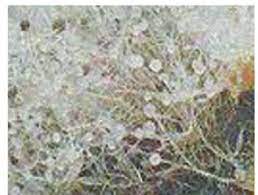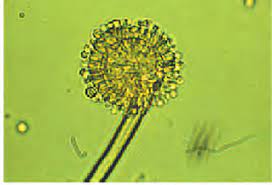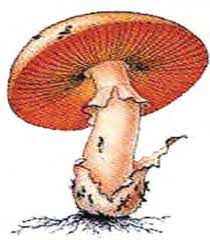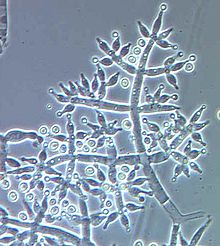
Kingdom Fungi
It is a unique kingdom of heterotrophic organisms.
They show a great diversity in morphology and habitat.
Fungi are cosmopolitan and occur in air, water, soil, and on animals and plants.
They prefer to grow in warm and humid places.
Fungi are filamentous (Except Yeast).
Their bodies consist of long, slender thread-like structures called hyphae and their network is known as mycelium.
Some hyphae are continuous tubes filled with multinucleated cytoplasm known as coenocytic hyphae.
The cell walls of fungi are composed of chitin and polysaccharides.
Examples:
The common mushroom and toadstools.
White spots seen on mustard leaves are due to a parasitic fungus.
Yeast is used to make bread and beer. (unicellular fungi)
Puccinia causes rusting in wheat.
Penicillin is a source of antibiotics.
Saprophytes:
Most fungi are heterotrophic and absorb soluble organic matter from dead substrates.
Parasites:
The fungi are heterotrophic and depend on living plants and animals.
They can also live as symbionts – in association with algae as lichens and with roots of higher plants as mycorrhiza.
Reproduction:
Vegetative means – fragmentation, fission, and budding.
Asexual reproduction is by spores called conidia or sporangiospores or zoospores.
Sexual reproduction is by oospores, ascospores, and basidiospores****.
The various spores are produced in distinct structures called fruiting bodies.
The fusion of protoplasms between two motile or non-motile gametes is called plasmogamy.
Fusion of two nuclei called karyogamy.
Meiosis in zygotes results in haploid spores.
When a fungus reproduces sexually, two haploid hyphae of compatible mating types come together and fuse.
Exception: In Ascomycetes and Basidiomycetes, an intervening dikaryotic stage (two nuclei per cell) occurs which is called a dikaryon and the phase is called dikaryophase of fungus.
Phycomycetes:

Members of Phycomycetes are found in aquatic habitats and on decaying wood in moist and damp places or as obligate parasites on plants.
The mycelium is aseptate and coenocytic.
Asexual reproduction takes place by zoospores (motile) or by aplanospores (non-motile).
These spores are endogenously produced in sporangium.
A zygospore is formed by the fusion of two gametes.
These gametes are similar in morphology (isogamous) or dissimilar (anisogamous or oogamous).
Examples: Mucor, Rhizopus (the bread mold), and Albugo (the parasitic fungi on mustard).
Ascomycetes:

They are mostly multicellular. (Exception: yeast or Saccharomyces)
They are saprophytic, decomposers, parasitic or coprophilous.
Mycelium is branched and septate.
The asexual spores are conidia produced exogenously on the special mycelium called conidiophores.
Conidia on germination produce mycelium.
Sexual spores are called ascospores which are produced endogenously in sac-like asci.
These asci are arranged in different types of fruiting bodies called ascocarps.
Examples: Aspergillus, Claviceps, and Neurospora.
Note: Many members like morels and truffles are edible and are considered delicacies.
Basidiomycetes:

They grow in soil, on logs and tree stumps, and in living plant bodies as parasites.
The mycelium is branched and septate.
The asexual spores are generally not found, but vegetative reproduction by fragmentation is common.
The sex organs are absent, but plasmogamy is brought about by the fusion of two vegetative or somatic cells of different strains or genotypes.
The resultant structure is dikaryotic which ultimately gives rise to basidium.
Karyogamy and meiosis take place in the basidium producing four basidiospores.
The basidiospores are exogenously produced on the basidium.
The basidia are arranged in fruiting bodies called basidiocarps.
Examples: Agaricus (mushroom), Ustilago (smut), and Puccinia (rust fungus).
Deuteromycetes:

They are commonly known as imperfect fungi because only the asexual or vegetative phases of these fungi are found.
Once perfect (sexual) stages of members of Deuteromycetes were discovered they were often moved to ascomycetes and basidiomycetes.
The Deuteromycetes reproduce only by asexual spores known as conidia.
The mycelium is septate and branched.
Some members are saprophytes or parasites while a large number of them are decomposers of litter and help in mineral cycling.
Examples: Alternaria, Colletotrichum, and Trichoderma.
Kingdom Fungi
It is a unique kingdom of heterotrophic organisms.
They show a great diversity in morphology and habitat.
Fungi are cosmopolitan and occur in air, water, soil, and on animals and plants.
They prefer to grow in warm and humid places.
Fungi are filamentous (Except Yeast).
Their bodies consist of long, slender thread-like structures called hyphae and their network is known as mycelium.
Some hyphae are continuous tubes filled with multinucleated cytoplasm known as coenocytic hyphae.
The cell walls of fungi are composed of chitin and polysaccharides.
Examples:
The common mushroom and toadstools.
White spots seen on mustard leaves are due to a parasitic fungus.
Yeast is used to make bread and beer. (unicellular fungi)
Puccinia causes rusting in wheat.
Penicillin is a source of antibiotics.
Saprophytes:
Most fungi are heterotrophic and absorb soluble organic matter from dead substrates.
Parasites:
The fungi are heterotrophic and depend on living plants and animals.
They can also live as symbionts – in association with algae as lichens and with roots of higher plants as mycorrhiza.
Reproduction:
Vegetative means – fragmentation, fission, and budding.
Asexual reproduction is by spores called conidia or sporangiospores or zoospores.
Sexual reproduction is by oospores, ascospores, and basidiospores****.
The various spores are produced in distinct structures called fruiting bodies.
The fusion of protoplasms between two motile or non-motile gametes is called plasmogamy.
Fusion of two nuclei called karyogamy.
Meiosis in zygotes results in haploid spores.
When a fungus reproduces sexually, two haploid hyphae of compatible mating types come together and fuse.
Exception: In Ascomycetes and Basidiomycetes, an intervening dikaryotic stage (two nuclei per cell) occurs which is called a dikaryon and the phase is called dikaryophase of fungus.
Phycomycetes:

Members of Phycomycetes are found in aquatic habitats and on decaying wood in moist and damp places or as obligate parasites on plants.
The mycelium is aseptate and coenocytic.
Asexual reproduction takes place by zoospores (motile) or by aplanospores (non-motile).
These spores are endogenously produced in sporangium.
A zygospore is formed by the fusion of two gametes.
These gametes are similar in morphology (isogamous) or dissimilar (anisogamous or oogamous).
Examples: Mucor, Rhizopus (the bread mold), and Albugo (the parasitic fungi on mustard).
Ascomycetes:

They are mostly multicellular. (Exception: yeast or Saccharomyces)
They are saprophytic, decomposers, parasitic or coprophilous.
Mycelium is branched and septate.
The asexual spores are conidia produced exogenously on the special mycelium called conidiophores.
Conidia on germination produce mycelium.
Sexual spores are called ascospores which are produced endogenously in sac-like asci.
These asci are arranged in different types of fruiting bodies called ascocarps.
Examples: Aspergillus, Claviceps, and Neurospora.
Note: Many members like morels and truffles are edible and are considered delicacies.
Basidiomycetes:

They grow in soil, on logs and tree stumps, and in living plant bodies as parasites.
The mycelium is branched and septate.
The asexual spores are generally not found, but vegetative reproduction by fragmentation is common.
The sex organs are absent, but plasmogamy is brought about by the fusion of two vegetative or somatic cells of different strains or genotypes.
The resultant structure is dikaryotic which ultimately gives rise to basidium.
Karyogamy and meiosis take place in the basidium producing four basidiospores.
The basidiospores are exogenously produced on the basidium.
The basidia are arranged in fruiting bodies called basidiocarps.
Examples: Agaricus (mushroom), Ustilago (smut), and Puccinia (rust fungus).
Deuteromycetes:

They are commonly known as imperfect fungi because only the asexual or vegetative phases of these fungi are found.
Once perfect (sexual) stages of members of Deuteromycetes were discovered they were often moved to ascomycetes and basidiomycetes.
The Deuteromycetes reproduce only by asexual spores known as conidia.
The mycelium is septate and branched.
Some members are saprophytes or parasites while a large number of them are decomposers of litter and help in mineral cycling.
Examples: Alternaria, Colletotrichum, and Trichoderma.
 Knowt
Knowt
